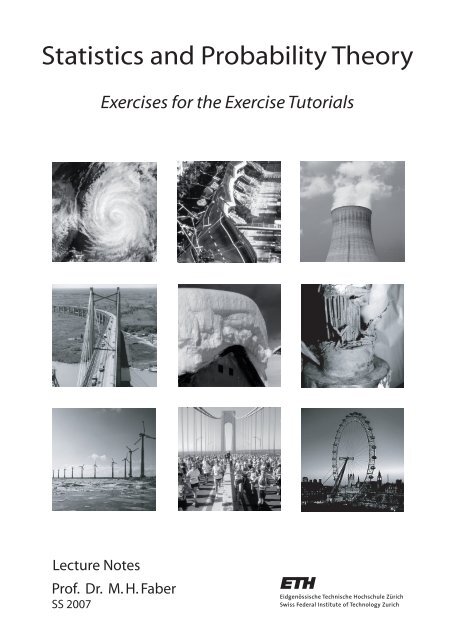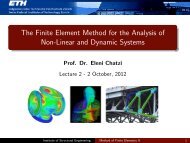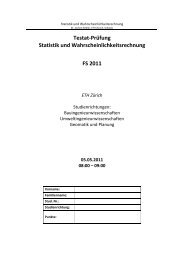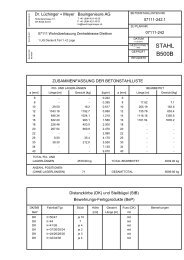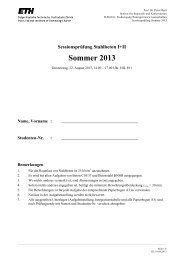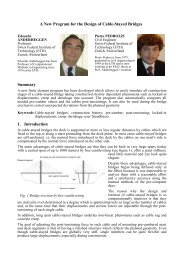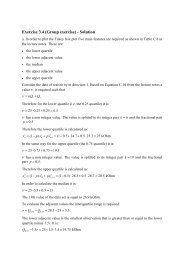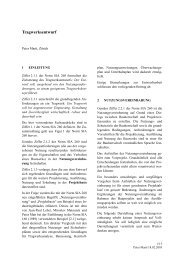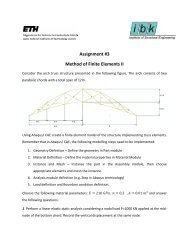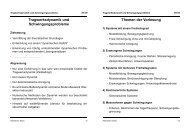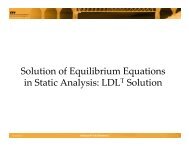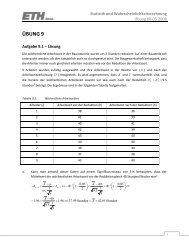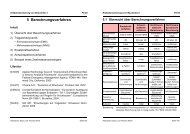Statistics and Probability Theory
Statistics and Probability Theory
Statistics and Probability Theory
Create successful ePaper yourself
Turn your PDF publications into a flip-book with our unique Google optimized e-Paper software.
<strong>Statistics</strong> <strong>and</strong> <strong>Probability</strong> <strong>Theory</strong><br />
Exercises for the Exercise Tutorials<br />
Lecture Notes<br />
Prof. Dr. M. H. Faber<br />
SS 2007
Copyright © 2007 Michael H. Faber
EXERCISE TUTORIAL 1<br />
Exercise 1.1<br />
In spite of a small seismic activity, the risk of a large earthquake with significant<br />
consequences always exists. A large earthquake may occur once in 1000 years. In a given<br />
region, 300 years have passed without a significant earthquake occurring. How large is the<br />
probability that a significant earthquake will occur in this region, in the current year?<br />
The probability has increased<br />
The probability has remained the same<br />
The probability has decreased<br />
□<br />
□<br />
□<br />
Exercise 1.2<br />
Considering an activity with only one event with potential consequences, the risk is that<br />
probability that this event will occur multiplied with the consequences given the event occurs-<br />
Which of the following events is associated with the highest risk?<br />
Event 1 2 3<br />
Event probability 10% 1% 20%<br />
Consequences 100 SFr 500 SFr 100 SFr<br />
Risk<br />
Exercise 1.3<br />
Following a number of different activities is given, which involve death as a possible<br />
consequence. Which is the riskiest one?<br />
Crossing a bridge<br />
Smoking 20 cigarettes per day<br />
Traveling 100000 km by train<br />
□<br />
□<br />
□<br />
Exercise 1.4<br />
In a region, an investigation was carried out of the number of storks <strong>and</strong> births. It was figured<br />
out that when the number of storks is high then the amount of births is also high <strong>and</strong> vice<br />
versa. The statistics indicate that these events – the number of births <strong>and</strong> the number of storks<br />
are correlated. What do you think?<br />
1.1
It has been proved statistically that the storks bring the children<br />
There is no direct connection between the two events so we cannot speak about<br />
correlation<br />
The statistical analysis has shown that the stork is a protected bird<br />
□<br />
□<br />
□<br />
Exercise 1.5<br />
A reinforced concrete bridge shows large cracks at mid span. As a result water can reach the<br />
reinforcement <strong>and</strong> eventually corrosion will initiate. What is more probable?<br />
A failure of the bridge at mid span under the action of an abnormal load<br />
A failure of the bridge under the action of an abnormal load<br />
□<br />
□<br />
Exercise 1.6<br />
Engineer Meier is “1000%” certain that the pedestrian bridge constructed by him is capable to<br />
withst<strong>and</strong> the load resulting from the bike racers taking part in the “Tour de Suisse”. Which<br />
statement is correct?<br />
Mr. Meier has made a wrong evaluation. A “200%” certainty would be enough<br />
If Mr. Meier made no miscalculations, he is right<br />
There is neither 1000% certainty nor absolute safety in civil engineering<br />
□<br />
□<br />
□<br />
Exercise 1.7<br />
In an Alp region, there are 25 very high summits. These are covered with snow over the entire<br />
year <strong>and</strong> each day there is the same probability of occurrence of an avalanche. This amounts<br />
to 1/40. How large is the probability in this region of at least two avalanches occurring at the<br />
same day? It is assumed that only one avalanche may occur on the same summit at the same<br />
day.<br />
Exercise 1.8<br />
A non destructive test method is carried out to determine whether the reinforcement of a<br />
structural component is corroded or not. From a number of past tests, it is known that the<br />
probability of the reinforcement being corroded is 1%. If the reinforcement is corroded, this<br />
will be indicated by the test. However there is also a 10% probability that the test will indicate<br />
that the reinforcement is corroded although this is not true (false indication).<br />
How large is the probability that corrosion is present, if the non destructive test indicates<br />
corrosion?<br />
1.2
EXERCISE TUTORIAL 2<br />
Exercise 2.1<br />
a. Which of the following expressions are meaningful in the way they are written?<br />
i) P ⎡⎣A∪[ B∩C]<br />
⎤⎦ ii) P[ A]<br />
+ P[ B]<br />
iii) P ⎡<br />
⎣A⎤∩<br />
⎦ P[ B]<br />
iv) P[ B ]<br />
b. Assume A, B <strong>and</strong> C represent different events. Explain in words the meaning of the<br />
following expressions <strong>and</strong> what they represent in mathematical terms (i.e. numbers,<br />
vectors, functions, sets).<br />
i) A∪ B ii) B ∩ C iii) P[ A ]<br />
iv) ⎡[ ]<br />
P A∩B∩C ∪⎡A∩B∩C⎤⎤<br />
⎣<br />
⎣ ⎦⎦<br />
v) ∅<br />
c. Using the diagram provided below show the following events.<br />
i) C D<br />
∩ ii) [ D\C] [ C A]<br />
∪ ∩ iii) B ∪ D<br />
Ω<br />
D<br />
C<br />
A<br />
B<br />
Exercise 2.2:<br />
We are throwing an ideal dice <strong>and</strong> considering the following events:<br />
Case 1). A: “An even number comes“<br />
B: “A number dividable by 3 comes“<br />
Case 2) A: “An even number comes”<br />
B: “A prime number comes”<br />
For each case, calculate the probability that both events (A <strong>and</strong> B) occur simultaneously.<br />
2.1
Exercise 2.3:<br />
The observation of the traffic flow at a crossing, see the following figure, shows that n 1 = 50<br />
vehicles move on the main road in direction 1. From those m 1 = 25 vehicles turn to the<br />
secondary road. n 2 = 200 vehicles move on the main load in direction 2 <strong>and</strong> m 2 = 40 vehicles<br />
turn to the secondary road. How large is the probability that a vehicle moving on the main<br />
road will turn to the secondary road?<br />
Secondary road<br />
m 1 +m 2<br />
n 1<br />
Main road<br />
n 2<br />
Exercise 2.4:<br />
Measurements are to be carried out with measurement devices. Since a large number of<br />
devices is required, 20% of them will be provided by IAC (Institute for the Atmosphere <strong>and</strong><br />
Climate) <strong>and</strong> 80% will be provided by IHW (Institute for Hydraulics <strong>and</strong> Water<br />
management). 5% of the devices provided by IAC do not fulfill the required accuracy, while<br />
2% of the devices provided by IHW do not fulfill the required accuracy.<br />
A student carried out a measurement using a device without knowing from which institute the<br />
device was provided. Thereby, she found the inaccuracy involved in the measurement. How<br />
large is the probability that the measurement was carried out with a device provided by IAC?<br />
Exercise 2.5:<br />
In exercise tutorial 1, exercise 1.8 was given as:<br />
A non destructive test method is carried out to determine whether the reinforcement of a<br />
structural component is corroded or not. From a number of past tests, it is known that the<br />
probability of the reinforcement being corroded is 1%. If the reinforcement is corroded, this<br />
will be indicated by the test. However there is also a 10% probability that the test will indicate<br />
that the reinforcement is corroded although this is not true (false indication).<br />
How large is the probability that corrosion is present, if the non destructive test indicates<br />
corrosion? Calculate the probability using the Bayes’ theorem.<br />
2.2
Exercise 2.6:<br />
The failure of a building in the city of Tokyo may be caused by two independent events:<br />
F<br />
1<br />
:<br />
F<br />
2<br />
:<br />
A big earthquake.<br />
A strong typhoon.<br />
The annual probabilities of occurrence of the above events are:<br />
PF (<br />
1) = 0.04<br />
PF (<br />
2) = 0.08<br />
Calculate the annual failure probability for the building.<br />
Exercise 2.7 (Group Exercise):<br />
Due to the increasing dem<strong>and</strong> on drinking <strong>and</strong> processing water, the groundwater discharge<br />
flow has to be discussed. The hazard of long-term ground-lowering is analysed, whereby it is<br />
assumed that the ground-lowering depends on the thickness of the clay layer, h . The<br />
thickness of the clay layer is classified in the following:<br />
C 0≤h≤<br />
20cm,<br />
C : 2<br />
20cm < h ≤ 40cm<br />
, C : 40cm < h<br />
3<br />
1 :<br />
Based on experience a geologist estimates the following prior probabilities that the thickness<br />
of the clay layer at a site belongs to one of the above cases:<br />
PC (<br />
1) = 0.2, PC (<br />
2) = 0.47 , <strong>and</strong> PC (<br />
3) = 0.33<br />
A geo-electrical test may be useful to update the prior probability on the ground category,<br />
although the test result may not always be correct. From past experience, the probabilities of<br />
the correct/false indication of the test are known as are listed in the (uncompleted) table<br />
below:<br />
Category of thickness<br />
of clay layer C<br />
i<br />
Indication of the category of the thickness of the clay layer<br />
I C 1<br />
I<br />
C<br />
= =<br />
2<br />
=<br />
3<br />
I<br />
C<br />
C<br />
1<br />
0.84 0.03<br />
C<br />
2<br />
0 0.77<br />
C<br />
3<br />
0.02 0.89<br />
Table 2.7.1:<br />
a. Complete the table.<br />
<strong>Probability</strong> of indication of the category of the thickness of the clay layer.<br />
b. A geo-electrical test was carried out <strong>and</strong> indicated as C<br />
3<br />
the thickness of the clay layer.<br />
What is the probability that the thickness of the clay layer belongs to C<br />
1<br />
, C<br />
2<br />
, C<br />
3<br />
?<br />
2.3
EXERCISE TUTORIAL 3<br />
Exercise 3.1<br />
Two sets of data are provided, each of which represents the daily traffic flow in<br />
Rosengartenstrasse in Zurich during the month of April 2001 (Table 3.1.1). Direction 1<br />
corresponds to driving towards Bucheggplatz, while direction 2 corresponds to driving<br />
towards Escher Wyss Platz.<br />
Date<br />
01.04.2001<br />
02.04.2001<br />
03.04.2001<br />
04.04.2001<br />
05.04.2001<br />
06.04.2001<br />
07.04.2001<br />
08.04.2001<br />
09.04.2001<br />
10.04.2001<br />
11.04.2001<br />
12.04.2001<br />
13.04.2001<br />
14.04.2001<br />
15.04.2001<br />
16.04.2001<br />
17.04.2001<br />
18.04.2001<br />
19.04.2001<br />
20.04.2001<br />
21.04.2001<br />
22.04.2001<br />
23.04.2001<br />
24.04.2001<br />
25.04.2001<br />
26.04.2001<br />
27.04.2001<br />
28.04.2001<br />
29.04.2001<br />
30.04.2001<br />
Direction 1 Direction 2<br />
unordered ordered unordered ordered<br />
32618<br />
24846<br />
24609<br />
17805<br />
33380<br />
24862<br />
29965<br />
18123<br />
34007<br />
25365<br />
30629<br />
19735<br />
33888<br />
28252<br />
30263<br />
20903<br />
35237<br />
29224<br />
31405<br />
21145<br />
35843<br />
29976<br />
31994<br />
22762<br />
33197<br />
30035<br />
26846<br />
22828<br />
30035<br />
30613<br />
22762<br />
23141<br />
32158<br />
32158<br />
30366<br />
24609<br />
33406<br />
32472<br />
29994<br />
26525<br />
34576<br />
32618<br />
30958<br />
26846<br />
34013<br />
32962<br />
30680<br />
27746<br />
24846<br />
33091<br />
19735<br />
28117<br />
28252<br />
33197<br />
21145<br />
28858<br />
25365<br />
33198<br />
17805<br />
28877<br />
24862<br />
33245<br />
18123<br />
29080<br />
32472<br />
33380<br />
28117<br />
29586<br />
33245<br />
33406<br />
28858<br />
29965<br />
33788<br />
33788<br />
29080<br />
29994<br />
34076<br />
33888<br />
30313<br />
30263<br />
29976<br />
33937<br />
23141<br />
30313<br />
29224<br />
34007<br />
20903<br />
30366<br />
32962<br />
34013<br />
27746<br />
30629<br />
33937<br />
34076<br />
29586<br />
30680<br />
33198<br />
34425<br />
30788<br />
30788<br />
34455<br />
34455<br />
31074<br />
30958<br />
35852<br />
34576<br />
32384<br />
31074<br />
33091<br />
35237<br />
26525<br />
31405<br />
30613<br />
35843<br />
22828<br />
31994<br />
34425<br />
35852<br />
28877<br />
32384<br />
Table 3.1.1: Daily traffic flow through Rosengartenstrasse, Zurich-April 2001.<br />
3.1
Provide frequency distributions <strong>and</strong> cumulative frequency distributions of the observed data.<br />
What is your first impression of the data? Try to make a comparison between the two<br />
directions.<br />
60<br />
55<br />
Direction 1<br />
Fraction of observations, %<br />
50<br />
45<br />
40<br />
35<br />
30<br />
25<br />
20<br />
15<br />
10<br />
5<br />
0<br />
24.5-26.5<br />
26.5-28.5<br />
28.5-30.5<br />
30.5-32.5<br />
32.5-34.5<br />
34.5-36.5<br />
Number of cars (*10 2 )<br />
3.2
40<br />
Direction 2<br />
Fraction of observations, %<br />
35<br />
30<br />
25<br />
20<br />
15<br />
10<br />
5<br />
0<br />
17.5-20.0<br />
20.0-22.5<br />
22.5-25.0<br />
25.0-27.5<br />
27.5-30.0<br />
30.0-32.5<br />
Number of cars (*10 2 )<br />
3.3
Exercise 3.2<br />
Use a Tukey box plot to provide a summary of the main features of the distribution of each<br />
data set of Table 3.1.1. Plot the Tukey box plots on the same graph so that you are able to<br />
compare these features. Do you observe any symmetry in the data sets?<br />
3.4
Exercise 3.3<br />
Make a Q-Q plot (Quantile-Quantile plot) to compare the two data sets of Table 3.1.1. What<br />
do you observe in regard to the traffic flows in directions 1 <strong>and</strong> 2? Provide an approximate<br />
value of the difference in the daily traffic flow between the two directions using a Tukey<br />
mean-difference plot.<br />
35000<br />
33000<br />
Number of cars in direction 1<br />
31000<br />
29000<br />
27000<br />
25000<br />
23000<br />
21000<br />
19000<br />
17000<br />
17000 19000 21000 23000 25000 27000 29000 31000 33000 35000<br />
Number of cars in direction 2<br />
8000<br />
7000<br />
6000<br />
Difference<br />
5000<br />
4000<br />
3000<br />
2000<br />
20000 22000 24000 26000 28000 30000 32000 34000<br />
Mean<br />
3.5
Exercise 3.4 (Group exercise)<br />
Resistivity measurements help to predict the possible corrosion of bridge structures. During a<br />
general bridge inspection the data shown in Table 3.2 were obtained from resistivity<br />
measurements along the two bridge lanes (direction 1 <strong>and</strong> 2):<br />
a. Draw two box plots for the data provided in Table 3.4.1 (direction 1 <strong>and</strong> direction 2).<br />
Show the main features of the box plots <strong>and</strong> write their values next to the<br />
corresponding points on the diagrams. Plot also the outside values, if any.<br />
b. Tukey box plot is a helpful tool for assessing the symmetry of data sets. Discuss the<br />
symmetry/skewness of the resistivity data for both lanes.<br />
c. Choose a suitable number of intervals <strong>and</strong> plot the histogram for the resistivity data of<br />
direction 1.<br />
Measurement Direction 1 Direction 2<br />
No. (i) Resistivity (kOhm) Resistivity (kOhm)<br />
1 20.2 3.8<br />
2 20.4 5.6<br />
3 22.1 6.5<br />
4 23.8 7.1<br />
5 24.3 7.9<br />
6 24.7 8.2<br />
7 25.3 9.1<br />
8 25.6 9.3<br />
9 25.7 9.6<br />
10 25.9 9.8<br />
11 26.2 10.3<br />
12 26.7 10.9<br />
13 26.9 11.1<br />
14 27.3 11.7<br />
15 27.6 12.2<br />
16 27.6 12.6<br />
17 27.8 12.9<br />
18 27.9 13.8<br />
19 28.3 13.9<br />
20 28.7 14.5<br />
21 28.9 15<br />
22 28.9 15.4<br />
23 29.3 17.1<br />
24 29.4 17.8<br />
25 29.9 23.4<br />
Table 3.4.1<br />
Resistivity measurements.<br />
3.6
Exercise 3.5<br />
The data sets in Table 3.5.1 show the number of newcomers to the university <strong>and</strong> the number<br />
of total students at the university. Estimate the correlation of these numbers using the<br />
following calculation sheet.<br />
Univ. A Univ. B Univ. C Univ. D Univ. E Univ. F<br />
Newcomer 3970 732 499 1300 3463 2643<br />
Total students 24273 5883 2847 5358 23442 17076<br />
Table 3.5.1:<br />
Number of newcomers to the university <strong>and</strong> number of total students at the university.<br />
Calculation sheet<br />
x<br />
i<br />
y<br />
i<br />
A 3970 24273<br />
B 732 5883<br />
C 499 2847<br />
D 1300 5358<br />
E 3463 23442<br />
F 2643 17076<br />
xi<br />
− x yi<br />
Σ - -<br />
Σ / n<br />
- -<br />
− y<br />
(x − x)<br />
i<br />
2<br />
(y y)<br />
2<br />
i<br />
−<br />
i i<br />
(x −x)(y − y)<br />
Σ / n - - - - -<br />
Exercise 3.6:<br />
Table 3.6.1 shows observations taken at weather stations located at different heights. Plot the<br />
relations between the temperatures (T max <strong>and</strong> T min ) <strong>and</strong> the heights of the weather stations in<br />
order to see the correlation between the temperatures <strong>and</strong> the heights. Then, calculate the<br />
correlation coefficient of the observed data – Height-T max <strong>and</strong> Height-T min .<br />
Table 3.6.1:<br />
Maximum <strong>and</strong> minimum temperatures observed at weather stations located at different<br />
heights through Switzerl<strong>and</strong>.<br />
3.7
Exercise 3.7:<br />
An experiment was carried out to measure the tensile strength of wood. The critical strength is<br />
assumed equal to the load at which the wood sample broke. In Table 3.7.1 the measured<br />
strengths have been classified in intervals of 5 N/mm 2 . The wood which is assumed to follow<br />
the same distribution as the tested wood is used for the construction of a building. The<br />
probability of failure or the reliability of the wood material can be estimated based on the<br />
measurement results. First draw the histogram <strong>and</strong> the cumulative frequency <strong>and</strong>:<br />
a. Estimate the probability that the tensile strength of wood lies between 20-25<br />
N/mm 2 .<br />
b. Estimate the probability of failure of the wood in the case where 25 N/mm 2 is loaded<br />
to the wood.<br />
Table 3.7.1:<br />
Classified measured wood tensile strengths.<br />
Exercise 3.8:<br />
Identify <strong>and</strong> write down the skewness features (right-skewed or left-skewed) of the<br />
distributions shown in the following figure. Then, mark the median, the mean <strong>and</strong> the mode<br />
for each distribution.<br />
B eDistribution B b Distribution<br />
f X<br />
(x)<br />
f X<br />
(x)<br />
x<br />
x<br />
3.8
EXERCISE TUTORIAL 4<br />
Exercise 4.1:<br />
The monthly expense X [CHF] for water consumption including sewage fee for a 2-persons<br />
household may be considered as a r<strong>and</strong>om variable with the following density function:<br />
⎧c⋅x⋅(60 −x) for 0 ≤ x ≤60<br />
fX<br />
( x)<br />
= ⎨<br />
⎩ 0 otherwise<br />
a. Which value of c should be chosen?<br />
b. Describe the distribution function FX<br />
( x ) of the r<strong>and</strong>om variable X .<br />
c. Which of the following four values, 30.00 CHF, 40.00 CHF, 48.30 CHF <strong>and</strong> 70.40 CHF<br />
does not exceed the 90%-quantile of the monthly expense?<br />
d. How large is the mean monthly expense for water consumption including sewage fee for a<br />
2-persons household?<br />
Exercise 4.2:<br />
The probability density function of a r<strong>and</strong>om variable is shown in Figure 4.2.1.<br />
f x (x)<br />
a. Describe the probability distribution function <strong>and</strong> the probability density function.<br />
b. Define the parameter h <strong>and</strong> identify the mode.<br />
c. Calculate the mean value for the case of a = 1, b = 2 , c = 3 <strong>and</strong> d = 6 .<br />
d. Calculate the value of the median.<br />
e. Determine graphically the median. Discuss how the mean value may be evaluated<br />
graphically.<br />
h<br />
a<br />
b<br />
c<br />
d<br />
x<br />
Figure 4.2.1:<br />
<strong>Probability</strong> density function.<br />
4.1
Exercise 4.3 (Group exercise):<br />
The probability density function of a r<strong>and</strong>om variable X is shown in Figure 4.3.1. In the<br />
interval [0, 4] the function is linear <strong>and</strong> in the interval [4, 12] the function is parabolic which<br />
is tangent to x-axis at point Q.<br />
Figure 4.3.1:<br />
<strong>Probability</strong> density function.<br />
a. Determine the coordinate of point P(x,y) <strong>and</strong> then describe the probability density<br />
function.<br />
b. Describe <strong>and</strong> draw the cumulative distribution function of X with some characteristic<br />
numbers in the figure.<br />
c. Calculate the mean value of X.<br />
d. Calculate P[X>4].<br />
4.2
EXERCISE TUTORIAL 5<br />
Exercise 5.1<br />
The marginal probability density functions of a two dimensional r<strong>and</strong>om variable<br />
( , )<br />
T<br />
Z = XY are defined as:<br />
f<br />
X<br />
⎧1<br />
⎪2<br />
⎪<br />
( x)<br />
= ⎨<br />
⎪⎪⎩ 0<br />
for −1 ≤ x ≤1<br />
otherwise<br />
<strong>and</strong><br />
3 (2<br />
2<br />
y y ) for 0 y 2<br />
⎧<br />
⎪ ⋅ − ≤ ≤<br />
4<br />
⎪<br />
fY<br />
( y)<br />
= ⎨<br />
⎪⎪⎩ 0 otherwise<br />
.<br />
The correlation coefficient ρ XY<br />
between X <strong>and</strong> Y equals to<br />
a. Calculate the expected value of 6X − 4Y + 2.<br />
b. Calculate the covariance Cov(6 X ;4 Y ) .<br />
1<br />
15 .<br />
c. Calculate the variance of 6X − 4Y + 2.<br />
d. Calculate the expected value of<br />
6 4<br />
2 2<br />
X − Y .<br />
Exercise 5.2<br />
Wind loads are considered in the design of buildings in a region. In order to specify the design<br />
wind load, wind speed is measured over a long period with a reliable measuring device (it is<br />
herein called “accurate device”). The number of days when the observation of wind speed<br />
exceeds a given threshold (60 km/h) is counted in each year.<br />
However, in previous years, the measurement has been undertaken with a less accurate device<br />
(it is herein called “less accurate device”). The correspondence between the measurement<br />
with the accurate device <strong>and</strong> the measurement with the less accurate device is of interest.<br />
Therefore, the joint probability of the measured wind speeds with both devices is established<br />
by calibration in the following next few years. Table 5.2.1 shows the joint probability of the<br />
numbers of the days when measured wind speed exceeds the threshold with the accurate<br />
device <strong>and</strong> with the less accurate device. N U represents the number of the days when the wind<br />
speed measured with the accurate device exceeds the threshold, <strong>and</strong> N G represents the number<br />
5.1
of the days when the wind speed measured with the less accurate device exceeds the<br />
threshold.<br />
N U = 0 N U = 1 N U = 2 N U = 3 P(N G )<br />
N G = 0 0.2910 0.0600 0.0000 0.0000<br />
0.3510<br />
N G = 1 0.0400 0.3580 0.0100 0.0000 0.4080<br />
N G = 2 0.0100 0.0250 0.1135 0.0300 0.1785<br />
N G = 3 0.0005 0.0015 0.0100 0.0505 0.0625<br />
P(N U ) 0.3415 0.4445 0.1335 0.0805<br />
∑ = 1.00<br />
Table 5.2.1: Joint probability of N G <strong>and</strong> N U .<br />
a. Calculate the probability that the number of days at which the wind speed, measured<br />
by each device, exceeds the threshold coincides.<br />
b. Assume that the accurate device always measures the exact wind speed. What are the<br />
probabilities that the wind speed which exceeds the threshold prevails 0, 1, 2 <strong>and</strong> 3<br />
time(s) in a year when the wind speed measured with the less accurate device exceeds<br />
the threshold twice?<br />
Exercise 5.3 (Group exercise)<br />
Highway bridges may require maintenance in their life time. The duration where no<br />
maintenance is required, T , is assumed exponentially distributed with the mean value of 10<br />
years. The maintenance activity takes some time, which is represented by S . The time S is<br />
also assumed exponentially distributed with the mean value of 1/12 year.<br />
a. Assuming that T <strong>and</strong> S are independent, obtain the distribution of the time between<br />
subsequent maintenance activities are initiated, Z , i.e., Z = T + S.<br />
b. How large is the probability PZ ( ≤ 5) ?<br />
c. Assume that two bridges in a highway system are opened <strong>and</strong> the times until the<br />
bridges require the maintenance are represented by T 1<br />
<strong>and</strong> T<br />
2<br />
, which are independent<br />
identically distributed as T . How large is the probability that in the next 5 years no<br />
maintenance is required for the two bridges?<br />
5.2
EXERCISE TUTORIAL 6<br />
Exercise 6.1<br />
Let r<strong>and</strong>om variables { X<br />
i} 1≤≤ i 50<br />
be independent, identically Normal distributed with the mean<br />
value of 1 <strong>and</strong> the st<strong>and</strong>ard deviation of 2. The following are defined:<br />
Sn<br />
= X1+ X2 + ... + X<br />
<strong>and</strong><br />
1<br />
Sn<br />
Xn<br />
= ( X1+ X2<br />
+ ... + Xn)<br />
=<br />
n<br />
n<br />
where n is equal to 50.<br />
n<br />
a. Calculate the mean <strong>and</strong> the variance of S<br />
n<br />
<strong>and</strong><br />
b. Calculate P( E[ X1] 1 X1 E[ X1]<br />
1)<br />
c. Calculate P( E[ Sn] −1≤ Sn ≤ E[ Sn]<br />
+ 1)<br />
.<br />
− ≤ ≤ + .<br />
d. Calculate P( E⎡Xn⎤−1≤ Xn ≤ E⎡Xn⎤+<br />
1)<br />
⎣ ⎦ ⎣ ⎦ .<br />
X<br />
n<br />
.<br />
Exercise 6.2<br />
A dike is designed to withst<strong>and</strong> a “1000-year return period flood”. How large is the<br />
probability that water will overflow the dike in the following cases:<br />
a. During a 10 year period, for first time in a given year?<br />
b. During a 10 year period, twice?<br />
c. Will not overflow during a 10 year period?<br />
d. During a 10 year period, at most once?<br />
e. During a 100 year period, 10 times?<br />
f. During a 100 year period, at most 10 times?<br />
g. During a 1000 year period, once or more often?<br />
It is assumed that flood occurs once a year.<br />
Exercise 6.3 (Group exercise)<br />
An environmental planning engineering company obtains a project in return for a project<br />
proposal with the success rate of 27%.<br />
Assume that you have taken over this company <strong>and</strong> you need to make the business plan for<br />
the forthcoming years.<br />
6.1
a. How large is the probability that the company will have at least one success after 12<br />
project proposals?<br />
b. How large is the probability that only the last of 10 project proposals is accepted?<br />
c. How large is the probability that at most 2 out of 13 project proposals are accepted?<br />
6.2
EXERCISE TUTORIAL 7<br />
Exercise 7.1<br />
The occurrence of rainfall in an area in a year may be described by a non-homogeneous<br />
Poisson process with the intensity, namely, the mean rate of occurrence of rainfall per unit<br />
time, () t is defined in the interval 0;13 <strong>and</strong> describes the time in a monthly unit<br />
λ t , where [ ]<br />
(i.e., 4 weeks).<br />
1. Month 2. Month<br />
13. Month<br />
t<br />
t=0<br />
t=1 t=2 t=13<br />
The intensity is defined as follows:<br />
⎧ 2t<br />
⎪ (0≤t<br />
≤3)<br />
3<br />
⎪<br />
λ( t) = ⎨ 2 (3< t ≤7)<br />
⎪13−<br />
t<br />
⎪ (7< t ≤13)<br />
⎩ 3<br />
a. Calculate the probability that in the first 5 months of a year, three or more rainfalls<br />
occur.<br />
b. Calculate the probability that a rainfall occurs at most once during the 8 th , 9 th <strong>and</strong> 10 th<br />
month <strong>and</strong> at most once during the last 3 months of a year.<br />
Hint: For a homogeneous Poisson process, the intensity λ()<br />
t varies with time. The mean<br />
occurrence rate ν for any time interval (t 1 , t 2 ) of the Poisson process can be described by:<br />
t2<br />
ν = ∫ λ( t)<br />
dt<br />
t1<br />
Exercise 7.2<br />
An earthquake hazard map is often represented in terms of peak ground acceleration <strong>and</strong> a<br />
return period of 475 years is adopted in the map in many countries.<br />
a. Show that the event with a return period of 475 years corresponds to the event whose<br />
occurrence probability is 10% in 50 years, under the assumption that an event follows<br />
a homogeneous Poisson process.<br />
b. What is the probability that an earthquake with a return period of 475 years will occur<br />
within the next 475 years?<br />
Hint: Assume that the occurrence of the earthquake follows a homogeneous Poisson process.<br />
7.1
Exercise 7.3<br />
The annual maximum discharge X of a particular river is assumed to follow the Gumbel<br />
distribution with mean μ =10.000 m 3 /s <strong>and</strong> st<strong>and</strong>ard deviation σ =3.000 m 3 /s.<br />
X<br />
a. Calculate the probability that the annual maximum discharge will exceed 15.000 m 3 /s.<br />
b. What is the discharge that corresponds to a return period T of 100 years?<br />
c. Find an expression for the cumulative distribution function of the river's maximum<br />
discharge over the 20 year lifetime of an anticipated flood-control project. Assume<br />
that the individual annual maxima are independent r<strong>and</strong>om variables.<br />
d. What is the probability that the 20-year-maximum discharge will exceed 15.000 m 3 /s?<br />
Hint: The Gumbel distribution function is expressed as:<br />
−∞ < x < ∞<br />
FX<br />
( x) = exp( −exp ( −α<br />
( x−u)<br />
))<br />
0.577216<br />
μX<br />
= u +<br />
α<br />
π<br />
σ<br />
X<br />
=<br />
α 6<br />
X<br />
μ<br />
σ<br />
u<br />
α<br />
X<br />
X<br />
− Mean<br />
− St<strong>and</strong>ard deviation<br />
− Parameter of the distribution<br />
− Parameter of the distribution<br />
Exercise 7.4 (Group exercise)<br />
Diesel engines are used, among others, for electrical power generation. The operational time<br />
T of a diesel engine until a breakdown, is assumed to follow an Exponential distribution with<br />
mean μ T = 24 months. Normally such an engine is inspected every 6 months <strong>and</strong> in case that a<br />
default is observed this is fully repaired. It is assumed herein that a default is a serious<br />
damage that leads to breakdown if the engine is not repaired.<br />
a. Calculate the probability that such an engine will need repair before the first<br />
inspection.<br />
b. Assume that the first inspection has been carried out <strong>and</strong> no repair was required.<br />
Calculate the probability that the diesel engine will operate normally until the next<br />
scheduled inspection.<br />
c. Calculate the probability that the diesel engine will fail between the first <strong>and</strong> the<br />
second inspection.<br />
( 0≤ ≤ ∩ ≤ ≤ ) = ( ( 0≤ ≤<br />
i i j j)<br />
)<br />
Hint: ( ) ( )<br />
P F t t F t t t P F t t where:<br />
7.2
t<br />
i<br />
: Inspection time<br />
t : Inspection time with j > i<br />
j<br />
F<br />
: No failure within the specified time<br />
d. A nuclear power plant owns 6 such diesel engines. The operational lives t 1<br />
, t 2<br />
,…, t 6<br />
of the diesel engines are assumed statistically independent. What is the probability that<br />
at most 1 engine will need repair at the first scheduled inspection?<br />
e. It is a requirement that the probability of repair at each scheduled inspection is not<br />
more than 60%. The operational lives t 1<br />
, t 2<br />
,…, t 6<br />
of the diesel engines are assumed<br />
statistically independent. What should be the inspection interval?<br />
7.3
EXERCISE TUTORIAL 8<br />
Exercise 8.1<br />
Consider a cuboid illustrated in the following figure. Measurements have been performed on<br />
a, b <strong>and</strong> f. It is assumed that the measurements involve the error ε that is assumed to be<br />
normally distributed, unbiased <strong>and</strong> with st<strong>and</strong>ard deviationσ .<br />
ε<br />
d<br />
f<br />
c<br />
a<br />
b<br />
a. Obtain the probability density function <strong>and</strong> probability distribution function of the<br />
error in d when this is assessed using the above measurements a, b <strong>and</strong> f.<br />
b. If the assessment of c is made in the same way, how large is the probability that the<br />
error in c is larger than 2.4 σ<br />
ε<br />
?<br />
Exercise 8.2<br />
In order to check the quality of the concrete production in a construction site, the compressive<br />
strength of the concrete produced were measured. Based on previous experience the<br />
compressive strength is assumed to follow the Normal distribution <strong>and</strong> its variance is assumed<br />
known <strong>and</strong> equal to 16.36 (MPa 2 ). Acceptance criterion of the concrete production is that the<br />
mean of the population of the produced concrete is more than or equal to 30 (MPa). 15<br />
samples have been tested <strong>and</strong> the results are shown in Table 8.2.1. Should the quality of the<br />
concrete production be accepted? Test the hypothesis at significance levels of 10% <strong>and</strong> 1%.<br />
Sample number (i) Compressive Strength (MPa) Sample number (i) Compressive Strength (MPa)<br />
1 24.4 9 30.3<br />
2 26.5 10 39.7<br />
3 27.8 11 38.4<br />
4 29.2 12 33.3<br />
5 39.2 13 33.5<br />
6 37.8 14 28.1<br />
7 35.1 15 34.6<br />
8 30.8 - -<br />
Table 8.2.1:<br />
Measured concrete compressive strength.<br />
8.1
Exercise 8.3<br />
A student living in Baden has read in a report that the mean driving time from Baden to ETH<br />
Hoenggerberg is 23.7 minutes with a st<strong>and</strong>ard deviation of 3 minutes. In the following 13<br />
days he made a note of his travel time <strong>and</strong> obtained the sample mean of 22.3 minutes.<br />
Assuming that the travel time is Normal distributed, testify the correctness o of the report at a<br />
significance level of 5%. (Assume that the st<strong>and</strong>ard deviation is known as being equal to 3<br />
minutes.)<br />
Exercise 8.4<br />
In a laboratory, 30 measurements are taken to control the water quality every day. Each<br />
measurement result is assumed to follow the Normal distribution with a mean of<br />
μ = 23 ng/<br />
ml <strong>and</strong> a st<strong>and</strong>ard deviation of σ = 4.3 ng/<br />
ml .<br />
a. How large is the probability that a measurement results in less than 23 ng/<br />
ml ? How<br />
large is the probability that a measurement result lies in the interval<br />
[19.5 ng/<br />
ml ; 20.5 ng/<br />
ml ]?<br />
b. How large is the probability of the daily mean being less than 20 ng/<br />
ml ?<br />
c. The lab bought a new instrument for measurements <strong>and</strong> decided to carry out a number<br />
of measurements in order to calibrate the new instrument with the old instrument. 15<br />
measurements were carried out <strong>and</strong> the result was summarized as: the sample mean is<br />
x =19 ng / ml <strong>and</strong> the sample st<strong>and</strong>ard deviation s = 5 ng / ml . Test at the 5%<br />
significance level if the measurement result from the new instrument belongs to the<br />
same population of the measurement result from the old instrument.<br />
Exercise 8.5<br />
The weekly working hours in the building industry were decided to be reduced by 2 hours. On<br />
a construction site it is to be tested whether this new rule is applied or not since the labor<br />
union insists that the workers work the same hours as before the reduction. 9 workers were<br />
selected r<strong>and</strong>omly <strong>and</strong> their weekly working hours were measured before ( X ) <strong>and</strong> after (Y )<br />
the reduction of the working hours. It is assumed that X <strong>and</strong> Y are Normal distributed. The<br />
variance of the weekly working hours before <strong>and</strong> after the reduction is assumed to be<br />
2 2<br />
σ<br />
X<br />
= σY = 9.5 hours 2 . The results are shown in the following table:<br />
a. Can it be said, based on the data, that the mean of the working hours before the<br />
reduction is 40 hours/week at the 5% significance level.<br />
b. Test the claim of the labor union at the 5% significance level.<br />
8.2
Number of workers (i) Working time before reduction (hours) Working time after reduction (hours)<br />
1 38 38<br />
2 41 39<br />
3 40 41<br />
4 42 39<br />
5 43 40<br />
6 40 40<br />
7 39 39<br />
8 37 38<br />
9 43 40<br />
Table 8.5.1:<br />
Working hours per week.<br />
Exercise 8.6<br />
Table 8.3 provides a number N of data on the daily traffic flow in Rosengartenstrasse in<br />
Zurich.<br />
Day (i) Number of cars<br />
1 3600<br />
2 4500<br />
3 5400<br />
4 6500<br />
5 7000<br />
6 7500<br />
7 8700<br />
8 9000<br />
9 9500<br />
Table 8.6.1:<br />
Number of cars.<br />
a. Construct the probability paper for the triangular distribution<br />
0 < x < 10000 .<br />
2<br />
f( x) = 2 /10000 x for<br />
b. Check if the daily traffic flow is triangularly distributed with the help of the<br />
probability paper.<br />
o<br />
Hint: Use the following cumulative distribution function: F( x ) =<br />
i<br />
i<br />
N + 1<br />
Exercise 8.7 (Group Exercise)<br />
To rebuild a car park, the arrival times of cars were measured. The time interval between<br />
arriving cars are shown in Table 8.7.1.<br />
a. Check graphically, if the time interval of car arrivals can be represented by an<br />
exponential distribution.<br />
8.3
. Calculate the mean value of the time interval of car arrivals. Under the assumption that<br />
the time interval is exponentially distributed, determine the mean value of the time<br />
interval from the graph produced in part (a.).<br />
i Time interval (seconds)<br />
1 1.52<br />
2 6.84<br />
3 9.12<br />
4 10.64<br />
5 15.2<br />
6 21.28<br />
7 30.4<br />
8 30.4<br />
9 34.2<br />
10 60.8<br />
11 78.28<br />
12 95.76<br />
Table 8.7.1:<br />
Time interval of arrival.<br />
o i<br />
Hint: Use the following cumulative distribution function: F( xi<br />
) =<br />
N + 1<br />
8.4
EXERCISE TUTORIAL 9<br />
Exercise 9.1:<br />
In order to model the concrete compressive strength of a certain concrete production, 20<br />
samples were measured <strong>and</strong> the result of the measurements is shown in Table 9.1.1. It is<br />
2<br />
assumed that the population of the samples follows the Normal distribution N( μ, σ ) .<br />
a. Describe the likelihood function.<br />
b. Estimate the unknown parameters (μ,σ) with the maximum likelihood method.<br />
c. Estimate the unknown parameters with the method of moment.<br />
No. of sample (i) Compressive strength (MPa) No. of sample (i) Compressive strength (MPa)<br />
1 24.4 11 33.3<br />
2 27.6 12 33.5<br />
3 27.8 13 34.1<br />
4 27.9 14 34.6<br />
5 28.5 15 35.8<br />
6 30.1 16 35.9<br />
7 30.3 17 36.8<br />
8 31.7 18 37.1<br />
9 32.2 19 39.2<br />
10 32.8 20 39.7<br />
Table 9.1.1:<br />
Compressive strength of 20 samples.<br />
Exercise 9.2:<br />
What happens if the Exponential distribution is assumed instead of the Normal distribution in<br />
exercise 9.1?<br />
a. Estimate the parameters of the Exponential distribution with the maximum likelihood<br />
method.<br />
b. Draw the cumulative distribution function with the estimated parameter, together with<br />
the observed cumulative distribution.<br />
9.1
Exercise 9.3 (Group Exercise):<br />
It is known that the data shown in Table 9.3.1 are the realizations of a r<strong>and</strong>om variable X<br />
α<br />
characterized by the cumulative distribution function FX<br />
( x)<br />
= x , 0≤<br />
x ≤1<br />
with unknown<br />
parameter α. Estimate the parameter α in the following method.<br />
a. Estimate the unknown parameter α with the method of moment.<br />
b. Estimate the unknown parameter α with the maximum likelihood method.<br />
c. Draw the cumulative distribution function with the estimated parameter in (b.) <strong>and</strong> the<br />
observed cumulative distribution.<br />
No. of data Realization<br />
1 0.22<br />
2 0.97<br />
3 0.92<br />
4 0.59<br />
5 0.39<br />
6 0.74<br />
7 0.81<br />
8 0.86<br />
9 0.39<br />
10 0.67<br />
Table 9.3.1:<br />
Realizations of a r<strong>and</strong>om variable.<br />
9.2
EXERCISE TUTORIAL 10<br />
Exercise 10.1:<br />
A dice is suspected to be asymmetric, resulting in the inhomogeneity of probability that each<br />
side of a dice comes out. In order to judge this suspicion statistically, 60 trials were made <strong>and</strong><br />
the result is shown in Table 10.1.1.<br />
a. Draw the relative frequency histogram, <strong>and</strong> compare with the uniform probability<br />
mass function under the assumption that the dice is symmetric.<br />
b. What is the probability that each side of the dice comes out 10 times respectively in 60<br />
trials when the dice is symmetric?<br />
c. Set the symmetry property of the dice as the null hypothesis <strong>and</strong> test the hypothesis<br />
2<br />
with the χ test at the 5% significance level.<br />
Side of the dice No. of realizations<br />
1 7<br />
2 12<br />
3 11<br />
4 10<br />
5 8<br />
6 12<br />
Sum: 60<br />
Table 10.1.1:<br />
Result of trials.<br />
Exercise 10.2:<br />
For the estimation of the concrete compressive strength of a certain concrete production, 20<br />
samples were measured <strong>and</strong> the result is shown in Table 10.2.1. It is assumed that the<br />
concrete compressive strength follows the Normal distribution.<br />
a. Estimate the unknown parameters of the distribution with the method of moments.<br />
b. Test the goodness of fit for the distribution with estimated parameters with the<br />
test at the 5% significance level. Adopt the intervals in Table 10.2.2.<br />
2<br />
χ<br />
10.1
No. of sample (i) Compressive strength (MPa) No. of sample (i) Compressive strength (MPa)<br />
1 24.4 11 33.3<br />
2 27.6 12 33.5<br />
3 27.8 13 34.1<br />
4 27.9 14 34.6<br />
5 28.5 15 35.8<br />
6 30.1 16 35.9<br />
7 30.3 17 36.8<br />
8 31.7 18 37.1<br />
9 32.2 19 39.2<br />
10 32.8 20 39.7<br />
Table 10.2.1:<br />
Compressive strength of 20 samples.<br />
Interval<br />
-30<br />
30-33<br />
33-36<br />
36-<br />
Sum<br />
N<br />
o,j<br />
j<br />
p(x ) N = np( x )<br />
p,j<br />
j<br />
2<br />
ε m<br />
Table 10.2.2:<br />
2<br />
Calculation sheet for the χ - goodness of fit test.<br />
Exercise 10.3:<br />
In order to underst<strong>and</strong> the role of the number of samples <strong>and</strong> the significance level in the<br />
hypothesis testing, the following experiment is made.<br />
50 realizations are simulated which follow the Normal distribution with the mean of 8 <strong>and</strong> the<br />
st<strong>and</strong>ard deviation of 1, see Table 10.3.1. The null hypothesis is that these realizations follow<br />
the Normal distribution with a mean of 7.5 <strong>and</strong> a st<strong>and</strong>ard deviation of 1 – therefore, it may be<br />
expected that the null hypothesis is rejected. Test the null hypothesis with the following given<br />
conditions with the Kolmogorov-Smirnov test.<br />
a. Test the null hypothesis at the 1% significance level, using only the first 20<br />
realizations.<br />
b. Test the null hypothesis at the 1% significance level, using 50 realizations.<br />
c. Test the null hypothesis at the 5% significance level, using only the first 20<br />
realizations.<br />
d. Test the null hypothesis at the 5% significance level, using 50 realizations.<br />
10.2
No. Realization No. Realization No Realization No. Realization No. Realization<br />
1 7.57 11 7.81 21 8.29 31 7.60 41 6.40<br />
2 6.33 12 8.73 22 6.66 32 8.69 42 8.26<br />
3 8.13 13 7.41 23 8.71 33 8.82 43 6.94<br />
4 8.29 14 10.18 24 9.62 34 8.71 44 9.42<br />
5 6.85 15 7.86 25 7.31 35 9.29 45 7.19<br />
6 9.19 16 8.11 26 8.86 36 8.67 46 8.53<br />
7 9.19 17 9.07 27 9.25 37 9.19 47 8.22<br />
8 7.96 18 8.06 28 6.41 38 6.80 48 7.08<br />
9 8.33 19 7.90 29 6.56 39 7.98 49 5.83<br />
10 8.17 20 7.17 30 8.57 40 7.84 50 7.94<br />
Table 10.3.1:<br />
Realizations.<br />
Exercise 10.4:<br />
The strength of 30 wood samples has been measured <strong>and</strong> the results are shown in Table<br />
10.4.1. The strength is assumed to follow an exponential distribution.<br />
a. Estimate the parameters of the exponential distribution using the method of moments.<br />
b. Draw the cumulative distribution function with the estimated parameters, together<br />
with the observed cumulative distribution.<br />
c. Test the goodness of fit for the exponential distribution with the<br />
significance level. Adopt the intervals in Table 10.4.2.<br />
2<br />
χ test at the 10%<br />
d. Test the goodness of fit for the exponential distribution with the Kolmogorov-Smirnov<br />
test at the 10% siginificance level. The parameter of the exponential distribution is<br />
assumed as λ = 0.04 .<br />
No. Strength (MPa) No. Strength (MPa) No. Strength (MPa)<br />
1 12.8 11 23.4 21 29.3<br />
2 16.3 12 26.8 22 29.5<br />
3 16.6 13 26.9 23 30.3<br />
4 16.9 14 27 24 32.1<br />
5 17.2 15 27.1 25 32.3<br />
6 17.9 16 27.2 26 33.5<br />
7 19.5 17 27.2 27 33.9<br />
8 21.9 18 27.5 28 35.6<br />
9 22.3 19 27.9 29 39.2<br />
10 22.5 20 28.3 30 43.5<br />
Table 10.4.1:<br />
Strength of wood samples.<br />
10.3
Interval<br />
-20<br />
20-25<br />
25-30<br />
30-<br />
Sum<br />
N<br />
o,j<br />
j<br />
p(x ) N = np( x )<br />
p,j<br />
j<br />
2<br />
ε m<br />
Table 10.4.2:<br />
2<br />
Calculation sheet for the χ - goodness of fit test.<br />
Exercise 10.5 (Group Exercise):<br />
The strength of 30 wood samples has been measured <strong>and</strong> the result is shown in Table 10.5.<br />
The strength is assumed to follow a Weibull distribution (with zero lower bound).<br />
a. Estimate the parameters of the Weibull distribution using the method of moments.<br />
b. Draw the cumulative distribution function with the estimated parameters, together<br />
with the observed cumulative distribution.<br />
c. Test the goodness of fit for the Weibull distribution with the test at the 10%<br />
significance level. Adopt the intervals in Table 10.4.2.<br />
d. Test the goodness of fit for the Weibull distribution with the Kolmogorov-Smirnov<br />
test at the 10% siginificance level. The parameters of the Weibull distribution are<br />
given by k = 4.00 <strong>and</strong> u = 28 from past experience.<br />
Hint: Cumulative distribution function of the Weibull distribution is written as:<br />
k<br />
⎧⎪<br />
⎛ x ⎞ ⎫⎪<br />
FX<br />
( x) = 1−exp⎨−⎜<br />
⎟ ⎬ , x > 0<br />
⎩⎪<br />
⎝u<br />
⎠ ⎭⎪<br />
The mean <strong>and</strong> st<strong>and</strong>ard deviation of Weibull distribution are given respectively as:<br />
⎛ 1 ⎞<br />
μ = uΓ ⎜1+<br />
⎟<br />
⎝ k ⎠ , ⎛ 2⎞ 2 ⎛ 1⎞<br />
σ = u Γ ⎜1+ ⎟−Γ ⎜1+<br />
⎟<br />
⎝ k ⎠ ⎝ k ⎠<br />
10.4
EXERCISE TUTORIAL 11<br />
Exercise 11.1 (Group Exercise):<br />
After heavy snowfall, you need to decide whether to clean up a roof from the snow or not.<br />
There is though also the possibility to carry out firstly a test to check the melting status of the<br />
snow on the roof. The test basically provides an indication, I , of the wetness of the snow on<br />
the roof.<br />
Therefore the decision problem is focused on either clean up the roof, do not clean up the roof<br />
or carry out first a test. In the following some information is provided to enable in the<br />
decision making.<br />
The cost associated with carrying out a test is equal to 1000 CHF. The clean up of the roof<br />
can be made from the local fire department. This option is associated with a cost equal to<br />
4000 CHF. In the case of collapse of the roof to the snow load the associated cost is equal to<br />
1.000.000 CHF.<br />
The probability of collapse of the roof has been estimated using First Order Reliability<br />
Methods (FORM). If the snow is dry, SD , the probability of collapse is: P ( ) = 10 −3<br />
f<br />
SD . If the<br />
snow is wet, SW , the probability of collapse is: P ( ) = 6.2⋅10 −3<br />
f<br />
SW . In case where there is no<br />
snow, SN , on the roof the probability of collapse is equal to: P ( SN ) = 5⋅10 −4 .<br />
The drawback of carrying out a test is that the test can provide a correct indication of the<br />
wetness, W , of the snow only in 75% of situations, PI (<br />
W<br />
W ) = 0.75 . You have a lot of<br />
experience in the assessment of snow wetness <strong>and</strong> based on this experience you believe that<br />
the probability that the snow on the roof is wet is equal to 0.6, PSW ( ) = 0.6.<br />
The decision tree is provided in Figure 11.1.1. Estimate the branch probabilities (where<br />
necessary since some have been already provided) <strong>and</strong> fill in the boxes the costs associated<br />
with the different events. Which decision is the most beneficial one in terms of cost?<br />
f<br />
11.1
Figure 11.1.1:<br />
Event tree.<br />
11.2
Exercise 11.2:<br />
An oil producer needs to make the decision of opening up, a 1<br />
, or not, a 2<br />
, a borehole at a<br />
location where there is an old oil well. However, he is not sure of whether such an action is<br />
advantageous or not. The well maybe dry, D , it may be contaminated, C , (i.e. will have oil<br />
but <strong>and</strong> other substances also) or it may contain oil, O . Those events have a –priori<br />
probabilities equal to 50%, 30% <strong>and</strong> 20% respectively.<br />
The benefit associated with the decision of opening up the borehole are estimated as the<br />
difference between the cost of opening the borehole <strong>and</strong> the cost benefit from the condition of<br />
the well (i.e. the income, if any, gained from the oil in the well). If the well is dry the benefit<br />
associated with opening up the borehole is -90.000 CHF. If the well is contaminated the<br />
benefit is equal to 50000 CHF <strong>and</strong> if the well has oil the benefit is equal to 170000 CHF.<br />
a. Carry out a prior decision analysis (using an appropriate event tree) <strong>and</strong> determine<br />
whether it is beneficial to open up the borehole.<br />
b. In order to receive some additional information regarding the state of the well the<br />
engineer can carry out a probe test that will cost 10000 CHF. The test can provide the<br />
following indications about the state of the well, WS :<br />
I<br />
D<br />
: the well is dry<br />
I<br />
C<br />
: the well is contaminated<br />
I<br />
O<br />
: the well has oil<br />
The information provided from the test is uncertain. The probabilities associated with a<br />
correct or false indication from the test about the state of the well given the true state of the<br />
well are given in the following table, P( I WS )<br />
WS<br />
State of the well<br />
Indication D : dry C : contaminated O : oil<br />
I<br />
D<br />
0.6 0.3 0.1<br />
I<br />
C<br />
0.1 0.3 0.5<br />
I<br />
O<br />
0.3 0.4 0.4<br />
Table 11.2.1: Likelihood of the true capacity of the well given the probe test results.<br />
Construct an appropriate decision tree <strong>and</strong> estimate whether it is beneficial to carry out a test<br />
(pre-posterior analysis).<br />
11.3
Exercise 11.3:<br />
A company is about to invest in the construction of a factory in a desert area. In order to<br />
maintain the machines <strong>and</strong> the workers, 100kl of water is needed in a day. There are two<br />
options: one option is to develop a well locally at the site (action A 1 ) while the other option is<br />
to construct a pipeline to get the water from another location (action A 2 ). The development of<br />
a well locally costs 10 million CHF whereas the construction of a pipeline it costs 100 million<br />
CHF. The problem is that it is not certain that the construction of a well locally will provide<br />
with sufficient water. In case that the construction of a well locally will not provide sufficient<br />
water, a pipeline will need to be constructed. Answer the questions following the instructions.<br />
a. (Prior analysis) Based on the experience from similar geological conditions, it is<br />
assumed that the probability that a local well will be able to supply enough water is<br />
40%. With this information, which action should the company support A 1 or A 2 ?<br />
The capacity of the well can be diagnosed by developing a small test well. It costs 1 million<br />
CHF to develop the small test well. However, the information obtained from the test well is<br />
only indicative, which means it cannot be known for sure whether there is sufficient water or<br />
not. The likelihood of the actual water capacity of the local well given a test result is<br />
described in Table 11.3.1:<br />
True capacity of the local well<br />
Indicators θ<br />
1<br />
:less than 100 kl θ<br />
2<br />
:larger than 100 kl<br />
I 1 : Capacity >105 kl 0.1 0.8<br />
I 2 : 95< Capacity


